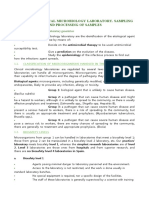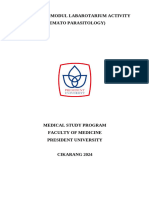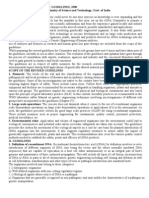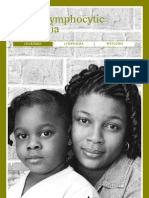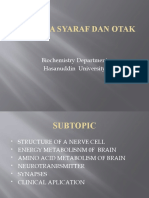Lecture Notes - 5 Health Monitoring
Lecture Notes - 5 Health Monitoring
Uploaded by
jekapu simwingaCopyright:
Available Formats
Lecture Notes - 5 Health Monitoring
Lecture Notes - 5 Health Monitoring
Uploaded by
jekapu simwingaOriginal Title
Copyright
Available Formats
Share this document
Did you find this document useful?
Is this content inappropriate?
Copyright:
Available Formats
Lecture Notes - 5 Health Monitoring
Lecture Notes - 5 Health Monitoring
Uploaded by
jekapu simwingaCopyright:
Available Formats
Lecture Notes: HEALTH MONITORING in Laboratory Animals
MICROBIOLOGICAL CLASSIFICATION
Lab animals can be classified according to their microbiological status thus:
1. Conventional:- harbour a range of (infectious) microorganisms, kept without
specific preventive hygiene measures and therefore of unknown
microbiological status; used in experiments after undergoing quarantine
2. Specific pathogen free (SPF):- are free from a number of potentially
pathogenic microorganisms. SPF designates which microorganisms are known
not to be present at the time of the last testing
3. Gnotobiotic:- are of defined microflora and are further divided into:
i. Germ-free (GF)- obtained via hysterectomy (re-derivation); are kept
under sterile conditions since they are highly susceptible to infection
ii. Colonisation resistant flora (CRF): GF animals can deliberately be
given flora to provide them with a general resistance to
colonisation/growth of other bacteria (colonisation resistance) and
reduce opportunistic infections. CRF are housed as GF and are often
used to start SPF colonies
The microbiological quality of experimental animals can critically influence
animal welfare and the validity and reproducibility of research data. It is
important that animals are free of agents (latent or apparent) that may interfere
with specific models or projects. Why?
Some may confound experimental data
Increase biological and experimental variability
Cause an increase in animal use
Some agents are zoonotic
Hence need for a laboratory animal health monitoring program (HM) as an
integral part of quality assurance. Aimed at breeders, users of laboratory animals
and describe essential elements including:
1. choice of agents
2. selection of animals and tissue for testing
3. frequency of sampling
4. common used test methods
5. interpretation of results
6. HM Reporting
Health Monitoring Page 1 of 4
Requirement of person with sufficient understanding of HM; Important that all
individual who work directly (animal care staff, technicians, researchers) and
indirectly (suppliers) understand the rationale of the HM Program
GENERAL CONSIDERATIONS IN DESIGN OF HM PROGRAM
Animal facilities are structured into microbiological units (MU), defined as a
self-contained microbiological entity, with separate space and traffic for animals,
personnel and materials.
HM Responsible defines the MU and schemes to the use of the unit
Barrier (Conventional) facility where personnel, equipment and animals
move freely; animals in open cages
Isolator
i. Microisolation cages- there is direct contacts allowing for horizontal
transmission
ii. Individually Ventilated cage (IVC)- laminar flow cabinet following strict
hygiene measure
The thoroughness of an HM Program must reflect the level of risk that applies to
particular unit and risk it poses to other units
Frequency of monitoring is determined by microbiological characteristics and
prevalence of infectious agents
High risk
i. Frequent introduction of animals eg >1/month
ii. Introduction of animals from different breeding colonies
iii. MU of varying microbiological status close together
iv. Movement of animals within the unit for manipulation and return
v. Access of insects, vermin to animal rooms, feed or bedding
vi. Multipurpose facilities with various kinds of experiments
vii. Frequent entry of research personnel into the MU
viii. Frequent turnover of animal care staff
ix. Shared equipment not easily shared
Low risk
i. Closed breeding colonies
ii. All in – all out system
iii. Occasional introduction of animals
iv. One or few types of experiments
Health Monitoring Page 2 of 4
Choice of agents to monitor
Is determined by several factors:
Animal health
Effects on confounding experimental data
Species specificity- some agents are species specific Sendai virus is a virus
of rodents
Zoonotic potential eg LCMV
Prevalence
Host factors (esp. immune status)
Desired MU status
Historical results,
Animals for testing and sampling
Animals resident within the MU give best results
Animals in same MU but in several rooms should be sampled from as many
rooms as possible
Sick and dead animals or their samples should be examined- outcome of
necropsy may prompt an increase in frequency of monitoring
Sentinel animals
When resident animals are not available or cannot be sampled (study protocol
limitations etc)
Are exposed to animals of the same species and submitted after adequate
exposure period
May be either indirect (animals that are exposed to materials soiled by
resident animals e.g. bedding, water, feed) or direct (animals that are placed in
the same cage as resident animals)
Should be housed in same units for a minimum of 6 weeks before testing using
same husbandry procedures
Generally should be of the same species as the test animals
Assays and Interpretation
Testing should be under supervision of adequately trained personnel usually
with a degree in microbiology, vet medicine with experience in lab animal science
Accredited laboratory for diagnosis advocated for
Detection of an infectious agent can be by various direct or indirect methods
i. Necropsy- systematic exam of euthanized (or dead) animals for lesions
Health Monitoring Page 3 of 4
ii. Histopathology should ensue on grossly identified lesion following
published general guidelines
iii. Skin and fur for evidence of parasites
iv. Serology for screening of microorganisms
Agglutination haemaglutination inhibition tests
Bead-based assays multiplex bead assays
ELISA- ubiquitous screening test
Western blots – good for confirmation due to the high specificity and
sensitivity
v. Molecular methods eg PCR useful for confirmation
vi. Culture techniques for detection of bacterial and fungal agents
Every assay can produce a false-positive and false-negative result hence
prevalence data is important in estimation of predictive value of test results i.e.
how much weight to accord a positive test result
Health Monitoring Report
HM Report is not the a laboratory report
HM Report should be produced by the person incharge of the HM Program and
should adopt a standardized format and must contain the following info
i. MU name and housing condition (barrier, isolator, IVC)
ii. Identification of all species, strains/stocks present within the unit. When
more than one species are reared in same barrier , there should be a HM
Report for each species
iii. Date of the latest test investigation and date of issue of the report
iv. Test frequency for each agent
v. Names of agents for which testing is undertaken to species level
vi. Test method used for each agent and name of testing lab
vii. Results of the latest investigation, and historical data as far as practicable
but at least 18months
viii. Results of pathological examinations recorded as lesions were/were not
observed
ix. A space for comments
x. Name and contact of person responsible for devising the HM Program
xi. Description of the overall HM Progam (link or by cover letter)
Health Monitoring Page 4 of 4
You might also like
- Infection ControlDocument23 pagesInfection ControlSanvar Mal Soni71% (7)
- MCDB 1A Midterm 1 2012Document10 pagesMCDB 1A Midterm 1 2012Kenji SoaresNo ratings yet
- 1.01.03 BiosafetyDocument11 pages1.01.03 BiosafetyWormInchNo ratings yet
- Micro NoeDocument63 pagesMicro NoejoseNo ratings yet
- MLT 107 Chapter 3 5 Infection Cont and QADocument29 pagesMLT 107 Chapter 3 5 Infection Cont and QACristina CunhaNo ratings yet
- MLS 422 Diagnostic MicrobiologyDocument50 pagesMLS 422 Diagnostic MicrobiologyMayowa OgunmolaNo ratings yet
- Modul Laboratorium Blok HematoParasitologyDocument16 pagesModul Laboratorium Blok HematoParasitologyhandaraop0No ratings yet
- 2.02.07_WILDLIFEDocument7 pages2.02.07_WILDLIFEbendifmr94No ratings yet
- Practical Manual for Detection of Parasites in Feces, Blood and Urine SamplesFrom EverandPractical Manual for Detection of Parasites in Feces, Blood and Urine SamplesNo ratings yet
- Handwashing Is The Single Most Important Measure To Reduce The Risks of TransmittingDocument3 pagesHandwashing Is The Single Most Important Measure To Reduce The Risks of TransmittingMaria OgabangNo ratings yet
- Lec. 1 LaboratoryDocument14 pagesLec. 1 LaboratoryDjdjjd SiisusNo ratings yet
- Public Health - Tutorial 1 Outbreak Investigation Typhoid and MalariaDocument3 pagesPublic Health - Tutorial 1 Outbreak Investigation Typhoid and MalariahalesipsumNo ratings yet
- Notes microbilogyDocument76 pagesNotes microbilogyBagadi MohiniNo ratings yet
- Gnu 2023 Updated Medical Parasitology and EntomologyDocument170 pagesGnu 2023 Updated Medical Parasitology and Entomologystellaakaliza866No ratings yet
- Biorisk Management (Part 1)Document91 pagesBiorisk Management (Part 1)Drafaf MahmoudNo ratings yet
- Clinical Microbiology and ImmunologyDocument7 pagesClinical Microbiology and ImmunologyGwyn CervantesNo ratings yet
- 5th Week Immunity - IDocument34 pages5th Week Immunity - ISahid Umarr Madieu KamaraNo ratings yet
- Bio Safety (Dr. Sri Harjati Suhardi) PDFDocument50 pagesBio Safety (Dr. Sri Harjati Suhardi) PDFchristinaNo ratings yet
- Medical Virology & ParasistologyDocument78 pagesMedical Virology & ParasistologyDev KadiyalaNo ratings yet
- Route of Exposure and Disease Transmission: 1. Biological MaterialsDocument16 pagesRoute of Exposure and Disease Transmission: 1. Biological MaterialsKaiser N. MadlumNo ratings yet
- Lab ManualDocument51 pagesLab ManualGS ShawonNo ratings yet
- FieldManual A Field Manual For Collection of Specimens To Enhance Diagnosis of Animal Diseases PDFDocument150 pagesFieldManual A Field Manual For Collection of Specimens To Enhance Diagnosis of Animal Diseases PDFrazadrpkNo ratings yet
- Clinical Parasitology Course Pack (Module 1-5)Document58 pagesClinical Parasitology Course Pack (Module 1-5)365 DaysNo ratings yet
- Basic Biosafety in The Laboratory: Introduction To Biosafety For Clinical MicrobiologistDocument51 pagesBasic Biosafety in The Laboratory: Introduction To Biosafety For Clinical MicrobiologistZllison Mae Teodoro MangabatNo ratings yet
- AsepsisDocument4 pagesAsepsisRejane GorospeNo ratings yet
- Micro 2Document9 pagesMicro 2Nabeela YousafNo ratings yet
- Muh. Nasrum Massi, MD., PH.D Makassar, Indonesia: Diagnostic and Treatment of Viral InfectionDocument26 pagesMuh. Nasrum Massi, MD., PH.D Makassar, Indonesia: Diagnostic and Treatment of Viral InfectionDavid CraigNo ratings yet
- Cpcsea PracticalDocument4 pagesCpcsea PracticalPavan ChavanNo ratings yet
- Preventive Veterinary MedicineDocument48 pagesPreventive Veterinary MedicineBorja Bueno Garcia100% (3)
- Asepsis and Infection ControlDocument10 pagesAsepsis and Infection ControlgilissaNo ratings yet
- PRINCIPES OF DIAGNOSIS, Bacteriology-1Document35 pagesPRINCIPES OF DIAGNOSIS, Bacteriology-1victorNo ratings yet
- microbiology & parasitologyDocument65 pagesmicrobiology & parasitologyIsaac DavidNo ratings yet
- Medical LaboratoryDocument21 pagesMedical LaboratoryeebookachipNo ratings yet
- Epidemiology & EcologyDocument18 pagesEpidemiology & EcologyPrantor KarmakerNo ratings yet
- Unit V Safety & RiskDocument67 pagesUnit V Safety & Riskvicky0457No ratings yet
- FUNDAMENTALS IN NURSING - Part 1Document5 pagesFUNDAMENTALS IN NURSING - Part 1arzooNo ratings yet
- Biosafety and Biosecurity in Veterinary LaboratoriesDocument12 pagesBiosafety and Biosecurity in Veterinary Laboratoriesseid yimerNo ratings yet
- walaa lec4Document37 pageswalaa lec4hasnalhrakeNo ratings yet
- Working With Human and Animal Cell CulturesDocument13 pagesWorking With Human and Animal Cell Culturesdahiphale1No ratings yet
- Asepsis and Infection ControlDocument6 pagesAsepsis and Infection ControlgilissaNo ratings yet
- Medical Micro Notes Print OutsDocument47 pagesMedical Micro Notes Print Outsbanjaraarush09No ratings yet
- Biosecurity Measures in Clinical PracticeDocument11 pagesBiosecurity Measures in Clinical PracticeAlmendra Montes De OcaNo ratings yet
- Sli Manual Tests ServicesDocument68 pagesSli Manual Tests ServicesashrafholailNo ratings yet
- Preventive Veterinary Medicine PDFDocument48 pagesPreventive Veterinary Medicine PDFMasum Rana100% (3)
- Quality Assurance of Vaccines by Shahid Ali Khan BraDocument49 pagesQuality Assurance of Vaccines by Shahid Ali Khan BraAsadullah MeharNo ratings yet
- 5 Introduction to Communicable Disease 1Document32 pages5 Introduction to Communicable Disease 1ynmorisiapnoNo ratings yet
- Parasitology Collection, Preservation of SpecimensDocument20 pagesParasitology Collection, Preservation of SpecimensSwar KlesNo ratings yet
- Lecture 1 - Bacterial and Fungal DiseasesDocument7 pagesLecture 1 - Bacterial and Fungal DiseaseslockairtimeservicesNo ratings yet
- Introduction to Bacteriology 2021Document29 pagesIntroduction to Bacteriology 2021Jan AsimNo ratings yet
- Amphibian VirologyDocument13 pagesAmphibian VirologyanitacmontoyaNo ratings yet
- Bio Safety Iitb HandoutDocument42 pagesBio Safety Iitb Handoutprobinhembram929No ratings yet
- Eae: Gene Encoding Intimim, The Gene Is Situated On The Locus of Enterocyte EffacementDocument5 pagesEae: Gene Encoding Intimim, The Gene Is Situated On The Locus of Enterocyte EffacementSKPACANo ratings yet
- Lecture_02 Laboratory Animals Welfare 2024Document38 pagesLecture_02 Laboratory Animals Welfare 2024lockairtimeservicesNo ratings yet
- Infection Control HandoutDocument5 pagesInfection Control HandoutSophia Bianca BarengNo ratings yet
- Introduction To Techniques in MicrobiologyDocument4 pagesIntroduction To Techniques in MicrobiologyYusnita Damayanti100% (1)
- Bioassay Techniques For Drug Development by Atta-Ur RahmanDocument214 pagesBioassay Techniques For Drug Development by Atta-Ur RahmanEmpress_MaripossaNo ratings yet
- Vaccine Development, Testing, and RegulationDocument12 pagesVaccine Development, Testing, and RegulationP Bijoya SinghaNo ratings yet
- Recombinant Dna Safety GuidelinesDocument9 pagesRecombinant Dna Safety Guidelinesrashmi_minocha93118No ratings yet
- Complete Lecture Note on MEDICAL PARASITOLOGYDocument66 pagesComplete Lecture Note on MEDICAL PARASITOLOGYjeffersonawesome28No ratings yet
- St. Joseph College of Health Science Name: REG NO: . MD4 Elective Research Proposal OutlineDocument2 pagesSt. Joseph College of Health Science Name: REG NO: . MD4 Elective Research Proposal Outlinejekapu simwingaNo ratings yet
- Informed Consent Form With Certificate 2020Document4 pagesInformed Consent Form With Certificate 2020jekapu simwingaNo ratings yet
- Proposal Template2020Document6 pagesProposal Template2020jekapu simwingaNo ratings yet
- Lecture Notes Lab Animal NutritionDocument8 pagesLecture Notes Lab Animal Nutritionjekapu simwingaNo ratings yet
- Lecture Notes - 7 Animal He Design - SafetyDocument6 pagesLecture Notes - 7 Animal He Design - Safetyjekapu simwingaNo ratings yet
- Adult Rodents - Chemical Methods 1. CO Asphyxiation: EUTHANASIA in Laboratory AnimalsDocument3 pagesAdult Rodents - Chemical Methods 1. CO Asphyxiation: EUTHANASIA in Laboratory Animalsjekapu simwingaNo ratings yet
- BmlsDocument5 pagesBmlsjekapu simwingaNo ratings yet
- BmlsDocument5 pagesBmlsjekapu simwingaNo ratings yet
- Bmls/2020/61899 CAT 2Document4 pagesBmls/2020/61899 CAT 2jekapu simwingaNo ratings yet
- BmlsDocument4 pagesBmlsjekapu simwingaNo ratings yet
- BCH1108 And1105 CatiiDocument1 pageBCH1108 And1105 Catiijekapu simwingaNo ratings yet
- Introductory Immunology: Basic Concepts for Interdisciplinary Applications. 3rd Edition Actor 2024 Scribd DownloadDocument37 pagesIntroductory Immunology: Basic Concepts for Interdisciplinary Applications. 3rd Edition Actor 2024 Scribd Downloadjoungameya9oNo ratings yet
- Diagnosis and Management of Pediatric Autoimmune PDFDocument16 pagesDiagnosis and Management of Pediatric Autoimmune PDFRamina PasariNo ratings yet
- Acute Lymphocytic LeukemiaDocument48 pagesAcute Lymphocytic Leukemia1434423100% (1)
- Microbiology of Ocular InfectionsDocument71 pagesMicrobiology of Ocular InfectionsryanradifanNo ratings yet
- Test 6 PharmacologyDocument25 pagesTest 6 Pharmacologysophiebureau102No ratings yet
- Leprosy: Guidelines For The Control ofDocument65 pagesLeprosy: Guidelines For The Control ofNovasiska HutajuluNo ratings yet
- ETANECEPTDocument3 pagesETANECEPTLucia MartinezNo ratings yet
- Carte OncoDocument186 pagesCarte OncoNicole.INo ratings yet
- A Topic Presentation ON: Emerging Communicable DiseasesDocument52 pagesA Topic Presentation ON: Emerging Communicable DiseasesGiri SivaNo ratings yet
- Salmonella SPP.: Hirendra D. Tadvi Unit: Clinical BacteriologyDocument19 pagesSalmonella SPP.: Hirendra D. Tadvi Unit: Clinical BacteriologyMeet VaghelaNo ratings yet
- Class:-9TH Subject: - Biology Chapter: - 4 (Why Do We Fall ILL)Document26 pagesClass:-9TH Subject: - Biology Chapter: - 4 (Why Do We Fall ILL)DEEPAK KaswanNo ratings yet
- Siwes Report CompleteDocument56 pagesSiwes Report Completeoluwaseyiadeyemiolajubu2005No ratings yet
- Bscbo 301 PDFDocument418 pagesBscbo 301 PDFparik kakani100% (1)
- Biotechnology: Module - 5Document26 pagesBiotechnology: Module - 5SUMAN DHOULAKHANDINo ratings yet
- Biokimia Syaraf Dan Otak: Biochemistry Department Hasanuddin UniversityDocument52 pagesBiokimia Syaraf Dan Otak: Biochemistry Department Hasanuddin Universityraynhard b. fandresNo ratings yet
- Sample Exam in MicrobiologyDocument23 pagesSample Exam in MicrobiologyleyluuuuuhNo ratings yet
- Last ExDocument60 pagesLast ExVijaya krishna YerriboinaNo ratings yet
- Blood Component TherapyDocument13 pagesBlood Component TherapyMohamed ElgayarNo ratings yet
- Phage Vectors: Dr. Rajesh PatelDocument50 pagesPhage Vectors: Dr. Rajesh Patelraj252000No ratings yet
- Saudi Journal of Biological Sciences: Siti Farida, Muhamad Sahlan, Etin Rohmatin, Robiatul AdawiyahDocument5 pagesSaudi Journal of Biological Sciences: Siti Farida, Muhamad Sahlan, Etin Rohmatin, Robiatul AdawiyahRobert TriarjunetNo ratings yet
- BIOLOGY - Science Notes For End of Year 9 AssessmentDocument7 pagesBIOLOGY - Science Notes For End of Year 9 AssessmentJenny DavidsonNo ratings yet
- Phytotherapy and Nutritional Supplements On Breast CancerDocument42 pagesPhytotherapy and Nutritional Supplements On Breast CancerGabrielAbarcaNo ratings yet
- UPV Fisheries ReviewerDocument79 pagesUPV Fisheries ReviewerEugene SaldivarNo ratings yet
- Prathamesh V. Kolekar Dept. Instrumentation Engg. Vishwakarma Institute of Technology, PuneDocument23 pagesPrathamesh V. Kolekar Dept. Instrumentation Engg. Vishwakarma Institute of Technology, PuneSajith KurianNo ratings yet
- Aseptic Technique and SterilizationDocument4 pagesAseptic Technique and Sterilizationcassandra-leigh-banaag-4482No ratings yet
- (Reading 5) Blood and Body Defenses-đã Chuyển ĐổiDocument18 pages(Reading 5) Blood and Body Defenses-đã Chuyển ĐổiTrúc Linh NguyễnNo ratings yet
- Cytoskeleton DADocument35 pagesCytoskeleton DAAnonymous NVBCqKWHNo ratings yet
- Metabolism NotesDocument208 pagesMetabolism Notesbairdman89No ratings yet
- Characterisation and Antimicrobial Activity of Sophora Alopecuroides L. Var. AlopecuroidesDocument7 pagesCharacterisation and Antimicrobial Activity of Sophora Alopecuroides L. Var. AlopecuroidesanascopelNo ratings yet



